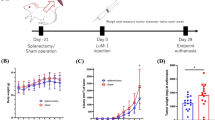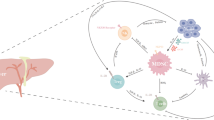Abstract
The function of the spleen in tumor development has been investigated for years. The relationship of the spleen with hepatocellular carcinoma (HCC), a huge health burden worldwide, however, remains unknown. The present study aimed to examine the effect of splenectomy on the development of HCC and the possible mechanism. Mouse hepatic carcinoma lines H22 and Hepa1-6 as well as BALB/c and C57 mice were used to establish orthotopic and metastatic mouse models of liver cancer. Mice were divided into four groups, including control group, splenectomy control group (S group), tumor group (T group) and tumor plus splenectomy group (T+S group). Tumor growth, metastases and overall survival were assessed at determined time points. Meanwhile, myeloid-derived suppressor cells (MDSCs) were isolated from the peripheral blood (PB), the spleen and liver tumors, and then measured by flow cytometery. It was found that liver cancer led to splenomegaly, and increased the percentage of MDSCs in the PB and spleen in the mouse models. Splenectomy inhibited the growth and progression of liver cancer and prolonged the overall survival time of orthotopic and metastatic models, which was accompanied by decreased proportion of MDSCs in the PB and tumors of liver cancer-bearing mouse. It was suggested that splenectomy could be considered an adjuvant therapy to treat liver cancer.
Similar content being viewed by others
References
Forner A, Llovet JM, Bruix J. Hepatocellular carcinoma. Lancet, 2012,379(9822):1245–1255
Yong KJ, Gao C, Lim JS, et al. Oncofetal gene SALL4 in aggressive hepatocellular carcinoma. N Engl J Med, 2013,368(24):2266–2276
Flores A, Marrero JA. Emerging trends in hepatocellular carcinoma: focus on diagnosis and therapeutics. Clin Med Insights Oncol, 2014,8:71–76
Wei KR, Yu X, Zheng RS, et al. Incidence and mortality of liver cancer in China, 2010. Chin J Cancer, 2014,33(8):388–394
Wei S, Hao X, Zhan D, et al. Are surgical indications of Barcelona Clinic Liver Cancer staging classification justified? J Huazhong Univ Sci Technolog Med Sci, 2011,31(5):637–641
Wei S, Xiong M, Zhan DQ, et al. Ku80 functions as a tumor suppressor in hepatocellular carcinoma by inducing S-phase arrest through a p53-dependent pathway. Carcinogenesis, 2012,33(3):538–547
Colovai AI, Giatzikis C, Ho EK, et al. Flow cytometric analysis of normal and reactive spleen. Mod Pathol, 2004,17(8):918–927
Mebius RE. Kraal G. Structure and function of the spleen. Nat Rev Immunol, 2005,5(8):606–616
Dieguez-Acuna FJ, Gygi SP, Davis M, et al. Splenectomy: a new treatment option for ALL tumors expressing Hox-11 and a means to test the stem cell hypothesis of cancer in humans. Leukemia, 2007,21(10):2192–2194
Cortez-Retamozo, V, Etzrodt M, Newton A, et al. Origins of tumor-associated macrophages and neutrophils. Proc Natl Acad Sci USA, 2012,109(7):2491–2496
Ugel S, Peranzoni E, Desantis G, et al. Immune tolerance to tumor antigens occurs in a specialized environment of the spleen. Cell Rep, 2012,2(3):628–639
Xia S, Li X, Cheng L, et al. Chronic intake of high fish oil diet induces myeloid-derived suppressor cells to promote tumor growth. Cancer Immunol Immunother, 2014,63(7):663–673
Shaked Y, Cervi D, Neuman M, et al. The splenic microenvironment is a source of proangiogenesis/inflammatory mediators accelerating the expansion of murine erythroleukemic cells. Blood, 2005,105(11):4500–4507
Prehn RT. The paradoxical effects of splenectomy on tumor growth. Theor Biol Med Model, 2006,3:23
Sonoda K, Izumi K, Matsui Y, et al. Decreased growth rate of lung metastatic lesions after splenectomy in mice. Eur Surg Res, 2006,38(5):469–475
Hanahan D, Weinberg RA. Hallmarks of cancer: the next generation. Cell, 2011,144(5):646–674
Gabrilovich DI, Nagaraj S. Myeloid-derived suppressor cells as regulators of the immune system. Nat Rev Immunol, 2009,9(3):162–174
Damuzzo V, Pinton L, Desantis G, et al. Complexity and challenges in defining myeloid-derived suppressor cells. Cytometry B Clin Cytom, 2015,88(2):77–91
Chi N, Tan Z, Ma K, et al. Increased circulating myeloid-derived suppressor cells correlate with cancer stages, interleukin-8 and -6 in prostate cancer. Int J Clin Exp Med, 2014,7(10):3181–3192
Li RJ, Liu L, Gao W, et al. Cyclooxygenase-2 blockade inhibits accumulation and function of myeloid-derived suppressor cells and restores T cell response after traumatic stress. J Huazhong Univ Sci Technolog Med Sci, 2014,34(2):234–240
Zhu XJ, Hu J, Sun L, et al. Amplification of functional myeloid-derived suppressor cells during stem cell mobilization induced by granulocyte colony-stimulationfactor. J Huazhong Univ Sci Technolog Med Sci, 2013,33(6):817–821
Schmid M, Zimara N, Wege AK, et al. Myeloid-derived suppressor cell functionality and interaction with Leishmania major parasites differ in C57BL/6 and BALB/c mice. Eur J Immunol, 2014,44(11):3295–3306
Movahedi K, Guilliams M, Van den Bossche J, et al. Identification of discrete tumor-induced myeloid-derived suppressor cell subpopulations with distinct T cellsuppressive activity. Blood, 2008,111(8):4233–4244
Youn JI, Nagaraj S, Collazo M, et al. Subsets of myeloid-derived suppressor cells in tumor-bearing mice. J Immunol, 2008,181(8):5791–5802
Condamine T, Ramachandran I, Youn JI, et al. Regulation of tumor metastasis by myeloid-derived suppressor cells. Annu Rev Med, 2015,66:97–110
Youn, JI, Collazo M, Shalova IN, et al. Characterization of the nature of granulocytic myeloid-derived suppressor cells in tumor-bearing mice. J Leukoc Biol, 2012,91(1):167–181
Murdoc, C, Muthana M, Coffelt SB, et al. The role of myeloid cells in the promotion of tumour angiogenesis. Nat Rev Cancer, 2008,8(8):618–631
Skabytska Y, Wolbing F, Gunther C, et al. Cutaneous innate immune sensing of toll-like receptor 2-6 ligands suppresses T cell immunity by inducing myeloid-derived suppressor cells. Immunity, 2014,41(5):762–775
Diaz-Montero CM, Salem ML, Nishimura MI, et al. Increased circulating myeloid-derived suppressor cells correlate with clinical cancer stage, metastatic tumor burden, and doxorubicin-cyclophosphamide chemotherapy. Cancer Immunol Immunother, 2009,58(1):49–59
Ren M, Ye L, Hao X, et al. Polysaccharides from Tricholoma matsutake and Lentinus edodes enhance 5-fluorouracil-mediated H22 cell growth inhibition. J Tradit Chin Med, 2014,34(3):309–316
Li P, Feng Z, Zhang G, et al. Inhibitory effect of recombinant endostatin on angiogenesis and tumor growth of hepatoma. J Huazhong Univ Sci Technolog Med Sci, 2003,23(3):223–226
Qin L, Wang X, Duan Q, et al. Inhibitory effect of melatonin on the growth of H22 hepatocarcinoma cells by inducing apoptosis. J Huazhong Univ Sci Technolog Med Sci, 2004,24(1):19–21, 31
Zhang B, Halder SK, Zhang S, et al. Targeting transforming growth factor-beta signaling in liver metastasis of colon cancer. Cancer Lett, 2009,277(1):114–120
Ding ZY, Jin, GN. Wang W, et al. Reduced expression of transcriptional intermediary factor 1 gamma promotes metastasis and indicates poor prognosis of hepatocellular carcinoma. Hepatology, 2014,60(5):1620–1636
Schwarz RE, Hiserodt JC. Effects of splenectomy on the development of tumor-specific immunity. J Surg Res, 1990,48(5):448–453
Brooks SP, Rich GA, Huh YS, et al. Lymphoid cell populations in splenectomized and nonsplenectomized SJL/J mice bearing Hodgkin’s disease-like reticulum cell sarcoma. J Pediatr Surg, 1986,21(12):1114–1118
Miwa H, Kojima K, Kobayashi T, et al. The tumor—immunological significance of splenectomy for cancer therapy. Nihon Geka Gakkai Zasshi, 1983,84(9):970–973
Jing-Shi W, Yi-Ni W, Lin W, et al. Splenectomy as a treatment for adults with relapsed hemophagocytic lymphohistiocytosis of unknown cause. Ann Hematol, 2015,94(5):753–760
Derlatka P, Grabowska-Derlatka L, Sienko J, et al. Splenectomy as a part of debulking surgery in patients with advanced ovarian cancer. Ginekol Pol, 2014,85(8):605–608
Santos FP, Tam CS, Kantarjian H, et al. Splenectomy in patients with myeloproliferative neoplasms: efficacy, complications and impact on survival and transformation. Leuk Lymphoma, 2014,55(1):121–127
Chen XP, Wu ZD, Huang ZY, et al. Use of hepatectomy and splenectomy to treat hepatocellular carcinoma with cirrhotic hypersplenism. Br J Surg, 2005,92(3):334–339
Solito S, Marigo I, Pinton L, et al. Myeloid-derived suppressor cell heterogeneity in human cancers. Ann N Y Acad Sci, 2014,1319:47–65
Hochst B, Schildberg FA, Sauerborn P, et al. Activated human hepatic stellate cells induce myeloid derived suppressor cells from peripheral blood monocytes in a CD44-dependent fashion. J Hepatol, 2013,59(3):528–535
Author information
Authors and Affiliations
Corresponding author
Additional information
This project was supported by the National Natural Science Foundation of China (No. 81001305, No. 81372495, No. 81202300, and No. 81372327).
Rights and permissions
About this article
Cite this article
Long, X., Wang, J., Zhao, Jp. et al. Splenectomy suppresses growth and metastasis of hepatocellular carcinoma through decreasing myeloid-derived suppressor cells in vivo . J. Huazhong Univ. Sci. Technol. [Med. Sci.] 36, 667–676 (2016). https://doi.org/10.1007/s11596-016-1643-2
Received:
Revised:
Published:
Issue Date:
DOI: https://doi.org/10.1007/s11596-016-1643-2




